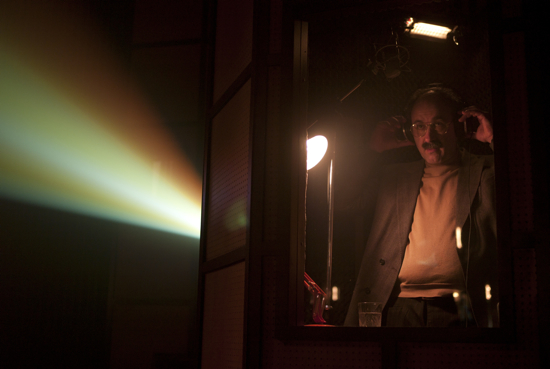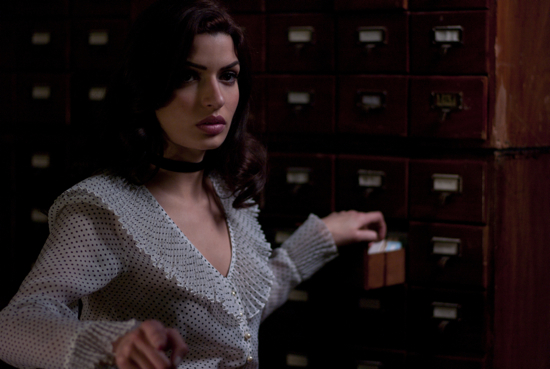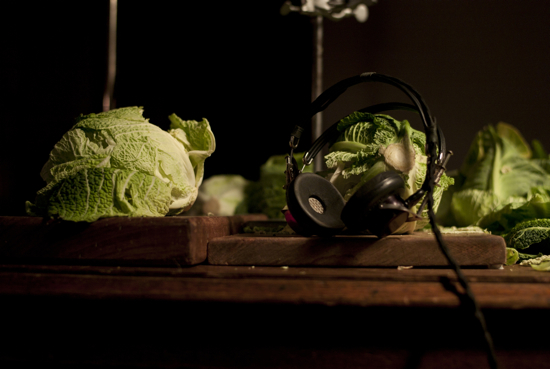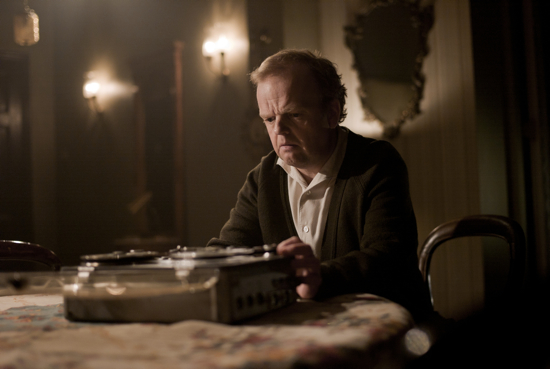A bloodcurdling scream lands on the wet sop of a demolished watermelon. The sudden clunk and hiss of magnetic tapes spinning into action accompany the rush from a harsh light source shining directly into your retina. The rhythmic hum of analogue machinery pulses softly. Horror has definitely been switched on.
But not in the way you’d expect. These are the sounds to the opening sequence of Peter Strickland’s new film Berberian Sound Studio. They introduce us to the dimly lit chambers of an Italian post-production studio, tinged in a subtle 1970s kitsch, where Gilderoy (Toby Jones), a meek sound engineer from Dorking, arrives to supervise the audio for a giallo feature. The Equestrian Vortex, directed by Santini (Antonio Mancino) is the movie at the centre of Strickland’s narrative. But we never see it. Save for some brilliant, blood red opening titles, The Equestrian Vortex exists only as a sheen of light on Gilderoy’s face as he watches from the Foley-stage, making sounds to accompany the horror using an array of wet vegetables.
Absent are the images of torture; of the ‘dangerously aroused goblin’ who terrorises the female protgonists in Santini’s picture. Instead, we watch the famous vocal performer and improviser Jean-Michel Van Shouwburg in character, as a tweed-wearing Foley artist. Silvia (Fatma Mohamed) and Claudia (Eugenia Caruso) provide the breathy, faintly sexualised Italian dubbing for the women lost in the poultry tunnel beneath the riding school and their recorded screams become a motif to which Berberian Sound Studio constantly returns, a shrill reprise.
What is most striking about the film is its meditation on the power of sound, and its determination to show its own mechanics. Through Gilderoy’s increasingly anxiety, Strickland asks questions about the morality of sound-making, cut alongside its satirical unravelling, as well as forcing us to question the implications of horror and its indulgence in cinema.
The original music by Broadcast, written and performed by James Cargill with vocals by the late Trish Keenan, is a perfectly pitched homage to the era depicted. There are hints of Morricone grandeur, plus the sweeping melodies coloured in synth-y dissonance of Riz Ortolani’s score for Cannibal Holocaust. But Strickland has also managed to summon the innocent, eager eccentricity of the garden shed enthusiast. It’s a clever counterpoint, as befits the impressive range and depth of the Reading-born writer-director’s influences, which he discussed at length in our interview.
When did the idea for Berberian Sound Studio first emerge?
Peter Strickland: It came from quite a few places, quite a while ago. I had made a version of it as a short film with the Bohman Brothers back in 2005, but it was sort of a joke back then. I always wanted to go back to it, because the violent element of Foley fascinated me. It seemed to be so unspeakable, but so ridiculous at the same time. I wanted to make a film where everything that is usually hidden in cinema, the mechanics of film itself, is made visible. Berberian… turns this on its head. Here, the film is out of view, and you only see the mechanics behind it. Like dissecting – not in a theoretical way, but in a physical way.
A lot of it came from listening to Cathy Berberian’s piece with Luciano Berio, Visage. It’s a 17-minute piece of howling. It really struck me that in the context of horror, something like this could really work. In horror, different kinds of music and sound are permissible. For example, Penderecki’s music: a lot of people would dismiss that as ‘difficult’, but when Kubrick uses it, you just get it. I remember Tim Gane giving an interview back in the ’90s, saying how horror is one of those genres where you can get away with so many leaps in logic in musical terms. There are so many good examples, even outside of giallo, like The Texas Chain Saw Massacre.

Musically, many things led me to Berberian…. Berio, Zucceri, and particularly Bruno Maderna and the Phonologia studio in Milan. Maderna was working with the likes of John Cage and Stockhausen, but he also did the Death Laid An Egg soundtrack. Then there was also the Gruppo di Improvvisazione Nuova Consonanza, who were like AMM in Italy. I realized this was quite unique, the crossover between experimentation and horror.
So, I imagined this scenario where academics are making their bucks on the side doing exploitation films. Berberian… began to swim around these two opposites, academia and trash, both of which I love.
In all, it’s a celebration of how visual analogue was. Digital doesn’t have that mystery to it; it doesn’t draw you in. I remember watching a documentary on Phonologia on YouTube, and I was amazed at how a simple zoom on a white noise generator is so strange, so powerful. It doesn’t matter that you don’t know what the machine does; in fact it’s more powerful that way.
I spoke with Peter Howell from the Radiophonic Workshop, and he talked a lot about the physical nature of working with analogue. The clumsiness of it, the talisman quality, the alchemy of it. Tape delay, distortion – it changes the soundworld so poignantly. It creates a darker, much more disturbing world. It goes back to what Delia Derbyshire or John Baker were doing, making recordings of concrete elements and transforming them. If you listen to those sounds on loops they become spell-like. You look at the tape boxes, and they start to look like sigils or some kind of pagan symbol, especially if you are up too late. You can see why some of the sound mixers and engineers became alcoholics or turned to the occult, like Joe Meek and Graham Bond. All this visual peculiarity, and the darker and more ambiguous side to sound-making, links to the English eccentric in his garden shed that I was keen to depict, mixed with the flamboyant Italian side.

In terms of depiction, you make a strong point that sounds are enough to summon images. We never see The Equestrian Vortex, but we never need to.
PS: There are so many links that bring those absent images into being, not only through sound. Leith Hill in Dorking [where Gilderoy is from] has ley lines running through it. Box Hill was where John Logie Baird made his first radiophonic experiments, which also ties into the chiffchaffs you see used in the witches potion later on. So there is an intersection between Gilderoy’s world back home and Santini’s horror film.
Also – and I don’t expect anyone to know this – but the Dorking chicken, which is the symbol of Dorking, actually comes from Milan. So the poultry tunnel under the riding academy pays tribute to that, while also referencing the Bruno Maderna soundtrack for Death Laid An Egg, which is all set in a poultry farm.
You don’t have to get all these references, but they all come together to colour Berberian…‘s world. In Dorking, I wanted to physically find a garden shed. So I travelled to one owned by a friend of a friend, who turned out to be an avid collector of all the Ghost Box records [the soundtrack includes Roj’s ‘Trance & Bilocation’, released by the Ghost Box label], which he had kept in the shed, a bizarre link.

In the final act, does Gilderoy begin to lose it because of a sense of responsibility for the sounds of horror he’s making?
PS: He definitely feels a sense of responsibility. The pivotal scene is ‘the red hot poker’ scene, where he thinks he can save a woman by refusing to make the sound of her torture. The whole paradox of it is that the more he refuses, the more he’s subjected to it. I found that wonderfully innocent and stupid of him. But I am careful to not spell out that he’s mad. I’m not sure that he is. I think he’s very disappointed with himself, which ties to his homesickness. But he knows he can’t retreat home, because somehow the chiffchaffs are part of the whole narrative, returning us to the question, did he ever really leave Dorking?
Because of these links, we always regarded the film and the filmmaking as a kind of spell. To be completely immersed in it is to be physically within the strip of soundtrack, to be in the sprockets, both for Gilderoy, for us as the filmmakers, and also for the audience.
You leave the question of Gilderoy’s mental state ambiguous. Is he descending into madness or is he just very good at Italian…
PS: …Or is he just a pawn? A cipher? Is he just our cipher, like in the Quay Brothers’ Street of Crocodiles, is he just someone interpolating this whole world?
I really love that element of it – that the sounds and his mental state can be in one sense completely serious, terrifying and dangerous, and in another, completely farcical. That’s what is so incredible about working with sound – the resonances that it can take on when it’s played with.
The soundtrack is completely diegetic. It was really important to have that concrete element – or that logical element, if you like – because the film does go off the rails a bit. There is always that anchor. We did cheat and extend a bit, but every single sound in the film comes from a source, the whole paradox being that we’re making a film about non-diegetic sound.
How did you find working with Toby Jones? He gives a great performance of a true amateur enthusiast, of the garden shed type you spoke of earlier.
PS: I was very aware that I was inexperienced and he’s worked with, well, nearly everyone. The real challenge for him was to make such a nondescript character engaging for an hour and a half. That amateur enthusiast element is crucial to the film. It’s a nice dichotomy against the Italian obsession with being ‘a professional’, and along comes Gilderoy, the professional enthusiast.
I’ve always loved the nature of being an amateur, and the haphazard way of making things that comes along with it. When you go into something out of love or enthusiasm it is chaotic. But equally, when you work on something obsessively, you do go a bit strange in the head.

As a homage to genre film, comparisons are inevitable. But who, building on the musical and sonic references you’ve already mentioned, influenced you cinematically?
PS: Actually, a lot of it came from rock and roll. Perhaps my sense of cinema is formed by sound, more than images. For example Suicide’s Alan Vega screaming, I found that incredibly physical. It transforms your blood pressure. Or Whitehouse, if you listen to Great White Death, it’s the video nasty that got away. Incredibly disturbing, more so than a lot of the films I’ve seen.
Some of it is referencing cinema, particularly The Cremator by Juraj Herz, the Czechoslovakian New Wave film. We referred to its title sequence for The Equestrian Vortex, the only part of that film that you do see. I love the way that [Czech animator] Jan Švankmajer tore and cut the bodies apart through collage.
Peter Tscherkassky was another influence. I saw his film Outer Space and I thought it was absolutely remarkable. He was taking horror – The Entity with Barbara Hershey – as his starting point and then completely splitting the atom with it. He fragmented it; it’s very academic, but also very rock and roll. It’s physical, visceral. In the soundtrack to Outer Space, the analogue buzz and distortion is completely fetishized. The texture is just so electric.
Genre is a starting point for me, that is my personal taste. I love to screw around with it. Of course, there were many giallo references, but it’s more about people making giallo, rather than becoming so itself. We pay lip service now and again in the way we use certain shots, certain zooms, but we wanted to depart from it too. It was the bombastic, rock and roll element that drew me. I mean, I don’t see Argento’s Suspiria as cinema: it’s more like psychedelia to me. I’m not interested in showing horror. But I am interested in the effects of it. Berberian… is a meditation on sound as much as it is a meditation on violence.
Berberian Sound Studio opens in UK cinemas today.



